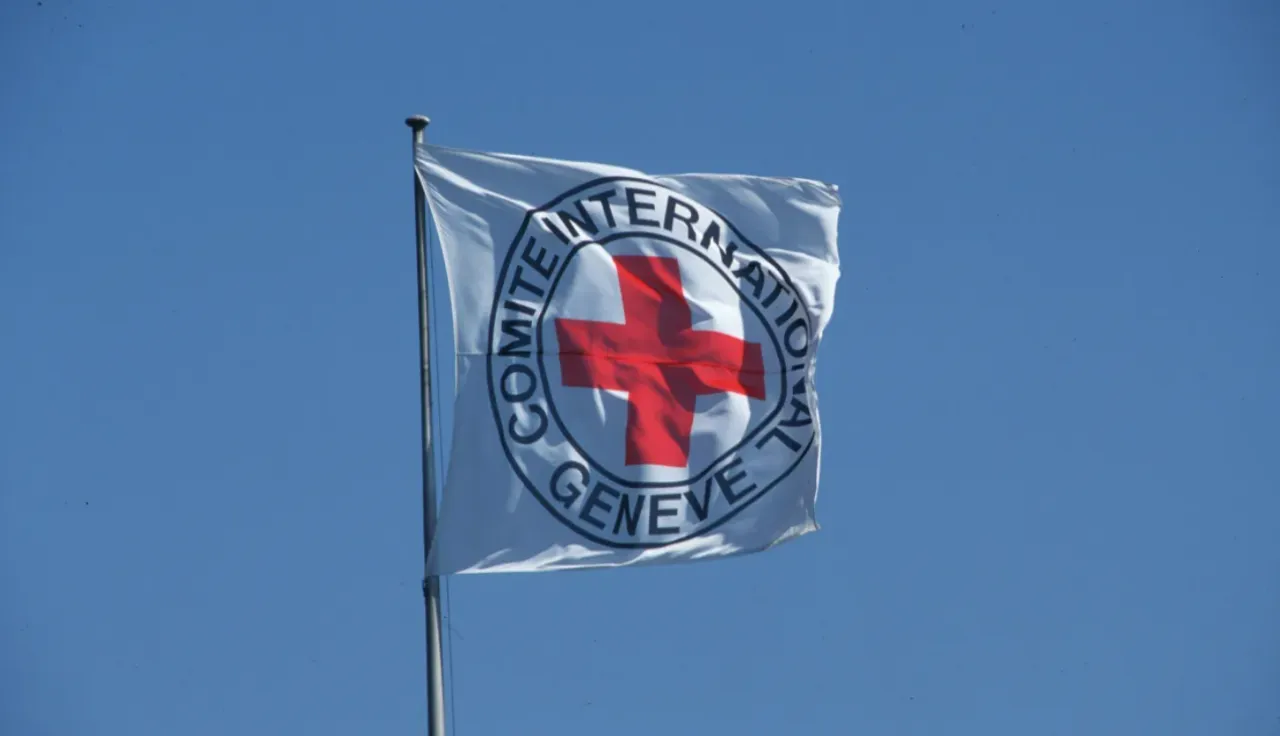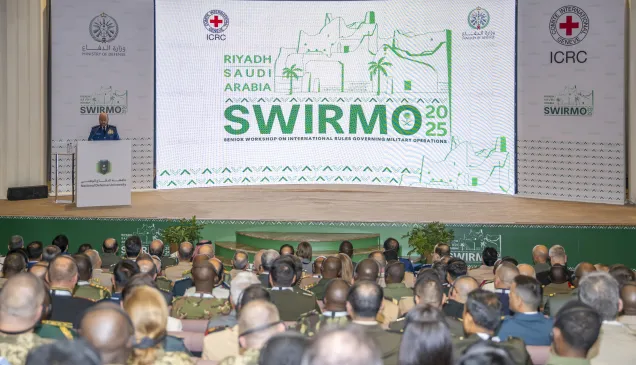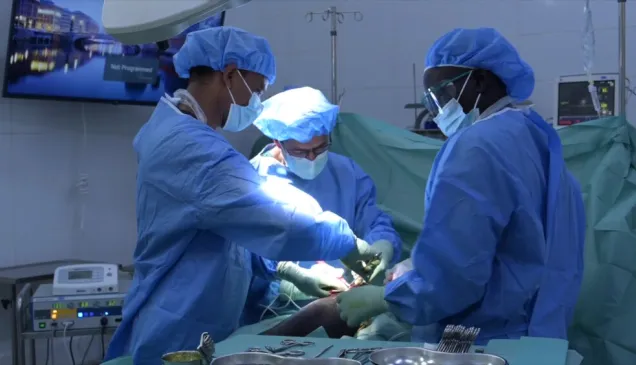Third Meeting of States Parties to the Treaty on the Prohibition of Nuclear Weapons

New York, 3–7 March 2025
Nuclear disarmament as a long-standing priority for the International Red Cross and Red Crescent Movement
1. Fifty-five years after the entry into force of the Treaty on the Non-Proliferation of Nuclear Weapons (NPT) and four years after the entry into force of the Treaty on the Prohibition of Nuclear Weapons (TPNW), the continued existence of nuclear weapons casts its deep shadow over the future of humanity. Current dynamics and geopolitical tensions, the ongoing modernization of nuclear arsenals, technological developments, changes in nuclear doctrines and unbridled rhetoric have alarmingly increased the risk that such weapons may be used deliberately or accidentally. History and science both show that any use of nuclear weapons would have catastrophic humanitarian consequences to which no State or international organization is capable of responding.
2. The International Committee of the Red Cross (ICRC), along with the other components of the International Red Cross and Red Crescent Movement (the Movement), has been calling for the prohibition and elimination of nuclear weapons ever since witnessing first-hand the horrific impact of the atomic bombs that targeted Hiroshima and Nagasaki in 1945, killing hundreds of thousands of innocent men, women, boys and girls and obliterating large parts of the two cities.[1] With the vast majority of hospitals destroyed and medical personnel killed or injured, assisting those who initially survived the blast was nearly impossible.
3. The Movement’s call for the prohibition and elimination of nuclear weapons was partly answered with the entry into force, in 2021, of the TPNW. The TPNW comprehensively prohibits nuclear weapons, a necessary step towards their elimination. In parallel, it provides pathways for future measures to achieve nuclear disarmament and verification thereof. The elimination of nuclear weapons is a legally binding obligation under Article VI of the NPT, which establishes an obligation to pursue multilateral negotiations on effective measures leading to nuclear disarmament.[2] According to the International Court of Justice (ICJ), this obligation is one of result, namely, to bring such negotiations to a conclusion and to agree on nuclear disarmament measures.[3] The TPNW constitutes an effective measure to implement Article VI of the NPT, complements the NPT and supports its objectives.
4. In line with the 2022–2027 Action Plan on the Non-Use, Prohibition and Elimination of Nuclear Weapons,[4] the Movement has undertaken a wide range of national and international activities to raise awareness of the immense human suffering caused by any use of nuclear weapons, the lack of capacity for a proper humanitarian response, and the urgent need for all States to reduce nuclear risks and work towards their complete elimination. The Movement has repeatedly called on all States to sign, ratify or accede to and faithfully implement the TPNW – including the Council of Delegates of the International Red Cross and Red Crescent Movement in its recent resolution “Weapons and international humanitarian law”[5] – as well as other complementary international instruments aimed at achieving a world without nuclear weapons, including the NPT, the Comprehensive Nuclear-Test-Ban Treaty and regional treaties establishing nuclear-weapon-free zones.
Towards a better understanding of the catastrophic humanitarian consequences of nuclear weapons
5. A nuclear-weapon detonation releases a combination of powerful blast waves, intense heat in the form of thermal radiation, and high amounts of ionizing radiation, which cannot be contained in space and time and will likely spread far beyond the target, potentially over great distances and across borders. Such a detonation, especially if occurring in or near a populated area, would bring about massive death and destruction, trigger large-scale displacement and cause long-term harm to human health and well-being, as well as long-term damage to the environment, infrastructure, socio-economic development and social order.
6. While much is known about the catastrophic humanitarian consequences of nuclear-weapon use and testing, many questions remain, requiring further research and study. For example, while it has been established that women and children are disproportionally affected by ionizing radiation, little is known about its effects on reproductive health. The role of biological sex as a factor in radiation harm among adults and children is an area for further research.
7. There is also a need for continued and scaled-up efforts to research and fully understand the humanitarian and environmental consequences of nuclear-weapon testing. Many communities in former nuclear testing areas report that they do not have sufficient information about their history of exposure, the current risks of living in a radioactively contaminated area and the intergenerational risks associated with radiation exposure. A lack of transparency and a failure to take into account communities’ perspectives, lifestyles and needs are shortcomings that need to be addressed in future research efforts.
8. Research into the various immediate and long-term impacts of nuclear-weapon use and testing is of paramount importance. Such research sheds light on the unique characteristics of these weapons; provides a crucial basis for humanitarian preparedness and response and for upholding the rights of the individuals and communities affected; and is essential to assessing the legality of the use of nuclear weapons under international humanitarian law.
9. Raising awareness of the catastrophic humanitarian consequences of nuclear weapons and using such knowledge to inform debates and decision-making can be an effective risk-reduction measure. When governments, the media and the general public understand the immediate and long-term consequences of any use of nuclear weapons, it inspires caution, strengthens the taboo against the use of nuclear weapons and builds support for progress on disarmament.
10. A very good step in this direction is the recently adopted United Nations General Assembly resolution “Nuclear war effects and scientific research”,[6] which establishes an independent scientific panel of experts mandated to examine the climatic, environmental and radiological effects of nuclear war, and their impacts on public health, global socio-economic systems, agriculture and ecosystems.
The unacceptability of nuclear threats
11. In recent years, threats of nuclear-weapon use have become commonplace. Nuclear threats raise serious concerns from a humanitarian, legal and ethical perspective. It should be stressed that there can be no distinction between so-called responsible and irresponsible threats of nuclear-weapon use. In light of the well documented, catastrophic humanitarian consequences of any use of nuclear weapons, and the impossibility of any State or organization adequately preparing for or responding to the massive humanitarian needs that would ensue, the prospect of nuclear-weapon use has a strong destabilizing effect on individuals and entire societies.
12. In addition, nuclear threats increase the probability of such weapons being used, by fuelling tensions and increasing the risk of escalation. Strident nuclear rhetoric and threats to use nuclear weapons, especially when repeated, risk normalizing the potential of nuclear-weapon use in political discourse and public opinion, thus eroding the long-established taboo against their use. Moreover, nuclear threats, in order to be credible, often require corroborating action – such as testing a delivery system or placing nuclear-capable forces on high alert. Such actions themselves increase the risks of nuclear-weapon use and contribute to escalating disputes and conflicts. Lastly, nuclear threats fuel the arms race and may even trigger proliferation, leading States to consider extended deterrence arrangements, or even the development or acquisition of nuclear weapons, as necessary for national self-defence.
13. In its 1996 advisory opinion on the legality of the threat or use of nuclear weapons, the ICJ stated that “if an envisaged use of weapons would not meet the requirements of humanitarian law, a threat to engage in such use would also be contrary to that law.” It concluded that “the threat or use of nuclear weapons would generally be contrary to the rules of international law applicable in armed conflict, and in particular the principles and rules of humanitarian law”.[7]
14. Since then, threatening to use nuclear weapons has been unequivocally prohibited under the TPNW. Furthermore, nuclear threats are inconsistent with the object and purpose of the NPT, as they fuel proliferation and undermine nuclear disarmament.[8] As noted in the TPNW preamble, any use of nuclear weapons would be abhorrent to the principles of humanity and the dictates of public conscience. By implying the possibility of actually using nuclear weapons, any threat to use nuclear weapons is – in the ICRC’s view – equally abhorrent.
15. Condemning and stigmatizing threats to use nuclear weapons can effectively reduce the risk of nuclear-weapon use. Consistent and unified condemnation by the international community discourages nuclear threats, lowers the risk of escalation and strengthens the nuclear taboo.
16. When it comes to nuclear deterrence, the ICRC, as a humanitarian organization, cannot but reject as contrary to the principles of humanity and the dictates of public conscience any security theories that rely on the threat of mass suffering and destruction. As a former president of the ICRC observed, the pursuit of theories of nuclear deterrence and mutually assured destruction has ultimately created an unstable balance of fear that continues to threaten all of humankind.[9]
Shaping the narrative: Universalizing the TPNW and its norms and principles
16. In the current bleak environment, marked by nuclear weapons’ increasingly prominent role in security policies, strengthened deterrence doctrines, repeated nuclear threats, multiple regional wars involving nuclear powers, and expanded nuclear sharing, universalizing the TPNW and its norms and principles is more important than ever.
17. The TPNW does not stand alone. It complements and reinforces the other instruments making up the broader nuclear disarmament and non-proliferation framework, including the NPT, the Comprehensive Nuclear-Test-Ban Treaty and the regional nuclear-weapon-free-zone treaties. The TPNW promotes the objectives of each of these treaties, countering the proliferation of nuclear weapons, prohibiting their testing, and targeting the establishment of a universal nuclear-weapon-free zone. We must build on this complementarity to replace polarization and divisions with trust, cooperation and synergies.
18. The TPNW makes the prohibitions in nuclear-weapon-free-zone treaties global. It is built on the recognition that the catastrophic humanitarian consequences of nuclear weapons transcend national borders and can be global in reach. Any use of nuclear weapons can also escalate into a broader conflict. While regional treaties are an important part of efforts to prohibit and eliminate nuclear weapons, those efforts must be a global undertaking.
19. Because the treaties share a common purpose and have similar key provisions, States party to nuclear-weapon-free-zone treaties can join the TPNW without substantial policy changes or burdensome new obligations. Joining the TPNW is the most effective, practical step that non-nuclear-weapon States can take towards eliminating nuclear weapons and freeing humanity from the threat of global catastrophe.
20. We must continue and enhance our collective efforts to increase the membership of the treaty. The ICRC is working actively with the Movement, States and the International Campaign to Abolish Nuclear Weapons to promote the universalization of the TPNW. In this context, the ICRC has recently produced factsheets[10] underscoring the shared objective and other commonalities of the TPNW and the five nuclear-weapon-free-zone treaties, and highlighting the TPNW’s added value.
Victim assistance and environmental remediation
21. The TPNW contains innovative obligations on international cooperation and assistance to redress the harm caused by past nuclear-weapon use and testing to people and the environment (Articles 6 and 7). These positive obligations around victim assistance and environmental remediation – included for the first time in a legal instrument prohibiting a weapon of mass destruction – are at the core of the treaty. Their implementation, while resting primarily with affected States, is a shared responsibility of all States Parties. The TPNW’s positive obligations are a testament to the importance of human security, which encompasses not only individual and collective health and well-being but also the environment, food security, the climate and, ultimately, the very future of the planet and of humanity as a whole, which is gravely threatened by the continued existence of nuclear weapons.[11]
22. As needs around victim assistance and environmental remediation are multifaceted, there are many ways for States to discharge their positive obligations. One of these could be the establishment of a trust fund to finance assistance to victims of nuclear-weapon testing or use and environmental-remediation measures for areas contaminated by such testing or use. In Action 29 of the Vienna Action Plan, adopted by the First Meeting of States Parties to the TPNW, States agreed to discuss the feasibility of, and propose possible guidelines for, establishing such an international trust fund.[12] The Second Meeting of States Parties decided that States would hold focused discussions on this matter in the context of the informal working group on Articles 6 and 7 of the treaty, with a view to examining the establishment of a trust fund at the Third Meeting of States Parties.[13]
23. Within the working group and with the valuable input of civil society, considerable work has been done on possible terms of reference for such a trust fund. Further progress on this issue is now needed if the treaty is to deliver on its promise to victims of nuclear weapons, affected communities and future generations who will be impacted by long-lasting environmental contamination.
Recommendations for the Third Meeting of States Parties
The ICRC recommends that States Parties use the opportunity provided by the Third Meeting of States Parties to:
a) adopt a declaration, whereby they:
- reiterate the deep concern over the catastrophic humanitarian consequences of any use of nuclear weapons and reaffirm the applicability of the principles and rules of international humanitarian law to such use
- underscore the security concerns that are posed by the continued existence of nuclear weapons and underpin the TPNW, as expressed by States in the consultative process
- call upon all States never to test or use nuclear weapons under any circumstance
- call upon all nuclear-weapon States and those that rely on nuclear weapons in their security postures to urgently take all necessary nuclear-risk-reduction measures, including diminishing the role of nuclear weapons in their military doctrines, immediately removing nuclear weapons from high operational alert and effectively implementing all other relevant commitments undertaken under the 2010 NPT Review Conference action plan
- condemn any threat of use of nuclear weapons, whether explicit or implicit, irrespective of the circumstances
- commit to continuing and strengthening efforts, within as well as outside the framework of the TPNW, to achieve the complete elimination of nuclear weapons, and reporting on progress at the first review conference
b) make progress towards the establishment of an international trust fund for victim assistance and environmental remediation within parameters that are both realistic and appropriate in light of the treaty’s object and purpose
c) agree on concrete actions to continue work on, and give effect to, the recommendations that emerged from the consultative process in relation to the security concerns that are posed by nuclear weapons’ continued existence and that underpin the TPNW
d) explore, develop and promote complementarity and synergies with the NPT and nuclear-weapon-free-zone treaties, together with all States party to those treaties, in particular as regards – but not limited to – the obligations on victim assistance and environmental remediation.
[1] L. Schroeder, The ICRC and the Red Cross and Red Crescent Movement: Working towards a nuclear-free world since 1945”, Journal for Peace and Nuclear Disarmament, Vol. 1, No. 1, March 2018, pp. 66–78: https://doi.org/10.1080/25751654.2018.1450623, all web addresses accessed February 2025. J. Kellenberger, Bringing the era of nuclear weapons to an end: Speech given by Mr Jakob Kellenberger, President of the International Committee of the Red Cross, to the Geneva Diplomatic Corps on 20 April 2010”, International Review of the Red Cross, No. 899, July 2016, pp. 883–886: https://international-review.icrc.org/articles/bringing-era-nuclear-weapons-end.
[2] NPT, Article VI: https://www.un.org/disarmament/wmd/nuclear/npt/text/. ICJ, Legality of the Threat or Use of Nuclear Weapons: Advisory Opinion of 8 July 1996 (“ICJ advisory opinion”), ICJ, The Hague, 1996, para. 99–101: https://www.icj-cij.org/files/case-related/95/7497.pdf.
[3] ICJ advisory opinion, para. 105(2)(f).
[4] Council of Delegates of the International Red Cross and Red Crescent Movement (Council of Delegates), , “Working towards the Elimination of Nuclear Weapons: 2022–2027 Action Plan”, Resolution 7, ICRC, Geneva, 2022: https://rcrcconference.org/
app/uploads/2022/06/CD22-R07-Nuclear-weapons_22-June-2022_EN_FINAL.pdf.
[5] Council of Delegates, “Weapons and International Humanitarian Law”, Resolution 3, ICRC, Geneva, 2024: https://rcrcconference.org/app/uploads/2024/10/CoD24_R3-Res-Weapons-and-IHL-EN.pdf.
[6] United Nations, Nuclear War Effects and Scientific Research: Resolution Adopted by the General Assembly,A/RES/79/238, United Nations, New York, 2024: https://digitallibrary.un.org/record/4070017.
[7] ICJ advisory opinion, para. 78 and 105.
[8] M. Spoljaric, statement at the 2024 session of the Preparatory Committee for the 2026 Review Conference, 25 July 2024: https://www.icrc.org/en/statement/treaty-non-proliferation-nuclear-weapons. See also the Republic of Nauru’s written submission to the ICJ advisory proceedings, p. 17: https://www.icj-cij.org/sites/default/files/case-related/95/8680.pdf.
[9] P. Maurer, remarks at the TPNW signing and ratification ceremony, 26 September 2019: https://www.icrc.org/en/document/not-end-cold-war-has-it-been-more-urgent-call-attention-consequences-nuclear-weapons.
[10] ICRC, The Treaty on the Prohibition of Nuclear Weapons and the Treaty of Tlatelolco, ICRC, Geneva, 2024: https://www.icrc.org/
en/publication/treaty-prohibition-nuclear-weapons-and-treaty-tlatelolco; The Treaty on the Prohibition of Nuclear Weapons and the Rarotonga Treaty, ICRC, Geneva, 2024: https://www.icrc.org/en/publication/rarotonga-treaty-and-tpnw; The Treaty on the Prohibition of Nuclear Weapons and the Bangkok Treaty, ICRC, Geneva, 2024: https://www.icrc.org/en/publication/bangkok-treaty-and-tpnw; The Treaty on the Prohibition of Nuclear Weapons and the Pelindaba Treaty, ICRC, Geneva, 2024: https://www.icrc.org/en/publication/pelindaba-treaty-and-tpnw; The Treaty on the Prohibition of Nuclear Weapons and the Semipalatinsk Treaty, ICRC, Geneva, 2024: https://www.icrc.org/en/publication/semipalatinsk-treaty-and-tpnw.
[11] ICRC, The Obligation to Assist Victims and Remediate the Environment within a Framework of Shared Responsibility under the Treaty on the Prohibition of Nuclear Weapons, ICRC, Geneva, 2023: https://www.icrc.org/en/publication/4702-obligation-assist-victims-and-remediate-environment-within-framework-shared.
[12] First Meeting of States Parties to the Treaty on the Prohibition of Nuclear Weapons, Draft Vienna Action Plan, TPNW/MSP/2022/CRP.7, United Nations, New York, 2022: https://documents.unoda.org/wp-content/uploads/2022/06/
TPNW.MSP_.2022.CRP_.7-Draft-Action-Plan-new.pdf.
[13] Second Meeting of States Parties to the Treaty on the Prohibition of Nuclear Weapons, Report of the Second Meeting of States Parties to the Treaty on the Prohibition of Nuclear Weapons, TPNW/MSP/2023/14, United Nations, New York, 2023: https://documents.un.org/doc/undoc/gen/n23/406/72/pdf/n2340672.pdf.



